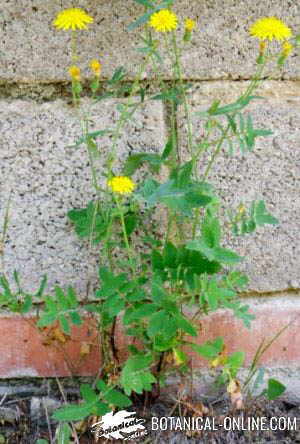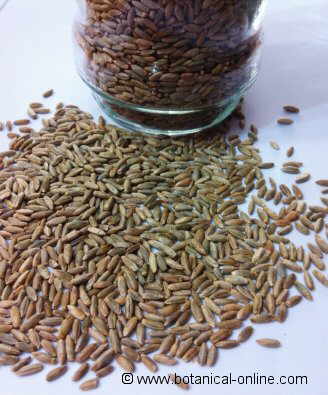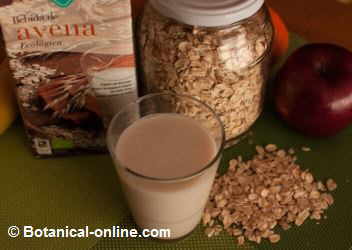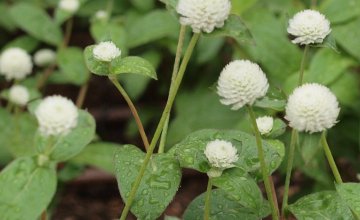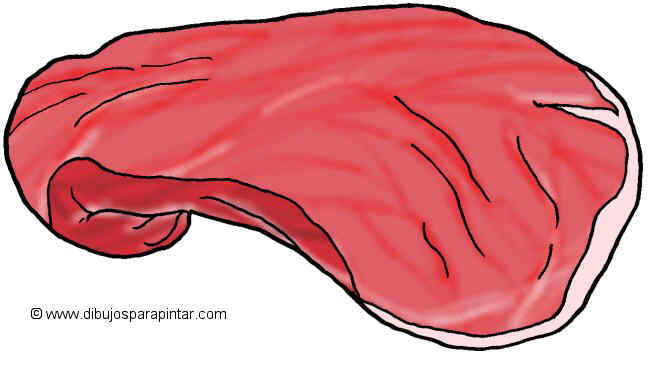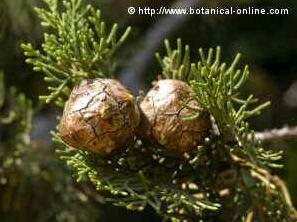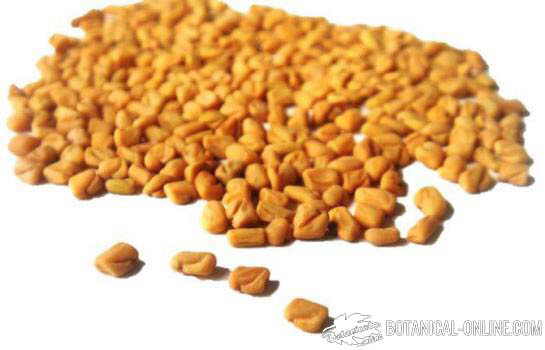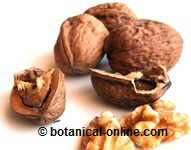Contents
PEPPERMINT MEDICINAL PROPERTIES
Peppermint is a very good digestive remedy
The beneficial properties of this plant for the digestive system have been praised since antiquity. Peppermint has been commonly used as other mints after meals to “settle” the stomach, avoiding flatulence, and helping digest food better. Specifically, the main properties are the following:
– Carminative: Its content in carvacrol, thymol and menthol help expel excess gas from the intestine (Infusion of 1 tablespoon or twice of tender leaves in a litre of water. Take a couple of cups a day after hot meals.)
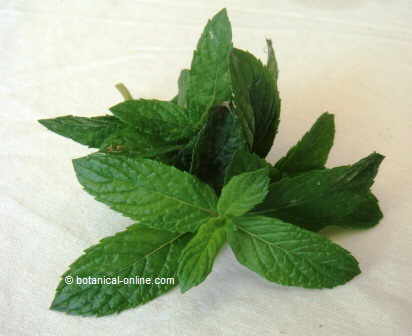
Photo of peppermint leaves
(Take capsules of peppermint oil specifically developed for the intestines available in pharmacies or stores. These capsules are designed to dissolve in the intestine instead of the stomach so that, when opened, in that part of the digestive tube they act directly in this area to help improve digestion and avoid the typical phenomena of flatulence or bloating related with malabsorption of fats)
– Stomachic: Most antispasmodic properties are conferred by terpenes together with carvacrol, limonene and cineol. Menthol has soothing properties and has traditionally been seen as a good anti-emetic.
Besides avoiding vomiting after large meals, peppermint prevents spasms and increases the production of bile juices, so it generally facilitates digestion and dissolves or prevents cramping.
As is the case of chamomile, one should not exceed the recommended therapeutic doses or use this plant for too long because it can produce the opposite effect, leading to stomach irritation. (Infusion of a spoonful of dried plant per cup of water. Take a couple of cups a day.)
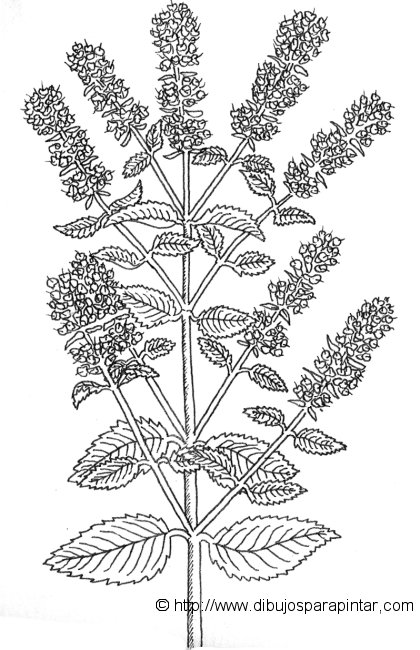
Drawing of peppermint, courtesy of
– Choleretic: Peppermint, like other mints, has the ability to stimulate the liver by increasing the secretion of bile, so, it can be used to promote digestion. For regular use, it is best to choose this mint to pennyroyal (Mentha pulegium), which contains more pulegone and isopulegone than peppermint and may irritate the stomach if you prolong your treatment too much.
– Relaxing for the intestines: The tannin content of this plant, the relaxing and antispasmodic properties of menthol as well as its soothing powers for the intestinal mucosa, can be profited to treat abnormalities associated with intestines.
Among the diseases that can be treated, we have the following: diarrhea, Crohn’s disease, irritable bowel syndrome, colitis, etc. (10 minutes infusion of a spoonful of dried plant. Drink two glasses a day)
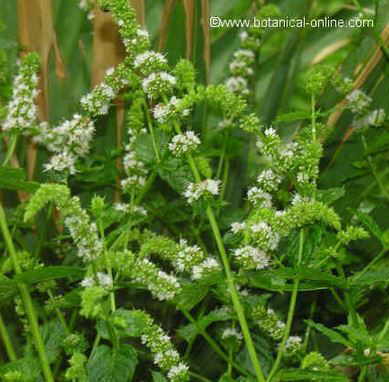
Peppermint flowers
BENEFITS OF PEPPERMINT IN INTERNAL USE
Peppermint is very suitable for respiratory diseases
Peppermint is rich in menthol, a component with anticongestive and diaphoretic properties, that’s to say, it increases sweat production and clears the airways.
These properties have been exploited in the treatment of cold and flu as it is capable of lowering the body temperature by means of sweat evaporation and opening the respiratory airways. (10 minutes infusion of a spoonful of dried plant. Drink two glasses a day)
The acetic acid and ascorbic acid content gives this plant mucolytic properties, meaning it helps dissolve mucus in the bronchi and facilitates their expulsion.
This determines that it can be used in the treatment of bronchitis. Here again, we must stress the importance of menthol and thymol. (10 minutes infusion of a spoonful of dried plant. Drink two glasses a day)
Thymol, along with luteolin, cineole and carvacrol offer antitussive properties, that, together with the soothing and antispasmodic properties of menthol, are very useful to reduce coughing that accompany many respiratory illnesses like asthma or pharyngitis.
This is the reason why many smokers or people suffering from cough usually carry mints in their pockets. (Lick a mint candy with a coughing fit.) (Infusion in cold water for 15 minutes of one tablespoon of the dried plant. Drink three glasses a day sipping occasionally)
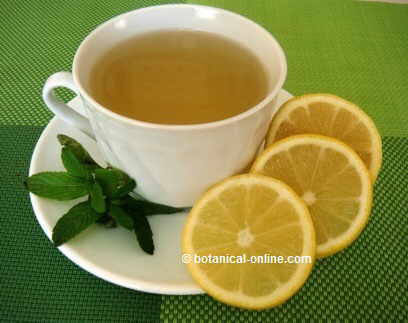
Infusion of peppermint with lemon and honey for cold
Peppermint before travelling if you get sick
Rosmarinic acid and eugenol provide anticoagulant properties, well suited to improve blood circulation.
This property can be exploited to avoid altitude sickness or improve its symptoms as more cell irrigation will allow more oxygen to arrive to the cells and will clean more cell toxins. (Infusion of a spoonful of dried plant per cup of water.
Take a couple of cups a day or two before making the trip to the mountains or the ascension)
Peppermint to improve circulation
The rosmarinic acid and eugenol give this plant anticoagulant properties, well suited to improve blood circulation. and to treat some disorders caused by poor circulation as headache.
When headache responds to indigestion problems, peppermint infusions of flowering tops are very useful (Take a couple of cups a day)
This property can be exploited to avoid altitude sickness or to improve its symptoms, as more cell irrigation allows more oxygen to the cells and increases toxins cleaning. (Infusion of a spoonful of dried plant per cup of water. Take a couple of cups a few days before embarking on a trip or before going to the mountains.)
Peppermint as stimulant
Peppermint is attributed with stimulant and toning effects.
BENEFITS OF PEPPERMINT IN EXTERNAL USE
Peppermint to treat pain
It has been found that peppermint oil has analgesic properties similar to those that salicylic acid has. Hence it has been used diluted to combat migraine or headaches, particularly in case of migraines, when the pain affects only a part of the head. (Dilute a few drops of peppermint oil in alcohol to impregnate a compress that must be applied to the temples or the temple of the affected person)
When a headache is due to indigestion problems, you can take an infusion of a spoonful of flowering tops per cup of water. (Take a couple of cups a day)
This application is also suitable for other types of pain, such as those affecting the joints of rheumatic and muscular pain problems., Neck pain, back pain, muscle strains, etc. In these cases it is also advisable to perform a poultice of leaves soaked in hot water to be applied directly on the painful area.
For sore throat gargles can be made with the liquid from the decoction of 30 g. of dried plant per liter of water.
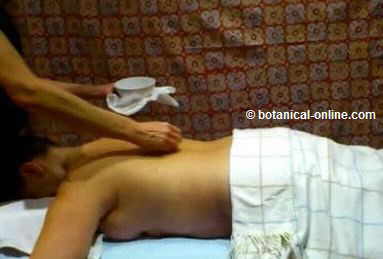
Peppermint can be very helpful to treat pain.
* Related information: Mint oil to treat pain (Wet a tissue and apply massage on the temples)
Peppermint in case of bad breath
Peppermint has many aromatic compounds that give it a strong and particular flavor. The industry uses it in soaps, toothpaste or mouth care products because it is able to mask the odor. Among the most disturbing odors is bad breath or halitosis.
Many toothpastes contain menthol because this component can conceal halitosis, by means of stimulating the production of saliva, as xerostomia or dry mouth is a major cause that produces not only bad breath but also tooth decay problems and gingivitis.
In all these cases peppermint may be useful to stimulate saliva production, masking odors and as a way to control odor-causing bacteria. (Place 3 drops of tincture in the mouth and stir well with the tongue by the teeth and gums) (Chew fresh leaves of the plant) (Perform mouthwashes with the infusion of a spoonful of dried plant per cup of water)
Peppermint for skin anomalies
Used externally, peppermint contains over 30 antiseptic principles (cineole, anethole, carvacrol, menthol, nerol, eugenol sabinene, caffeic acid, etc.) It also has over 40 antibacterial principles and, in addition, it constitutes a great a vulnerary.
All this makes this plant an excellent remedy for the treatment of skin abnormalities, such as:
– Wounds cicatrization, wash wounds with the liquid resulting from the infusion of 3 tablespoons of dried plant in a liter of water. Wash your wounds when the water is cold. Use a gauze soaked with a few drops of essential oil diluted. (Not essential oil can be applied to the skin undiluted)
– Itching: The same preparation applied to the skin helps reduce itching, producing a sense of relief and freshness. (Apply crushed fresh leaves on the affected area)
– Insect bites: The anti-inflammatory, antiseptic and astringent properties of peppermint are adequate to relieve itching and reduce swelling caused by insect bites, like bees, lice, fleas, mosquitoes, tiger mosquitoes, ticks, etc.. (Wash the affected area with the liquid from the infusion of the dried plant.)
– Eczema: The same remedy, applied on eczema, help improve skin health.
– Female genital tract: Mint has over 30 components with antiseptic properties. In external use, it can be used to treat infections of the vulva and vagina eliminating the microorganisms that cause infection and relieving itching or vaginal itching (vulvitis, vulvovaginitis, vaginitis, vaginal discharge) (Wash with the decoction of 30 g. dried plant per liter of water)
– Hemorrhoids: Being astringent, anti-inflammatory and vulnerary, it is useful in treating external hemorrhoids. (A topical application of the liquid resulting from a decoction of 30 g. dried plant per liter of water can help reduce inflammation and prevent itching)
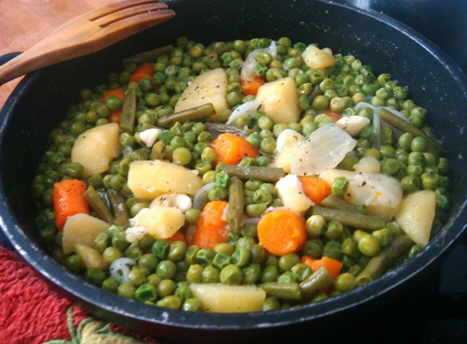
Peppermint is used in vegetable dishes to make them more digestible.
FOOD PROPERTIES OF PEPPERMINT
Besides being a medicinal plant, peppermint is very well known as an aromatic herb mint. The main mints used in cooking are spearmint (Mentha viridis = Mentha spicata) and peppermint (Mentha x piperita).
Of these two mints, the most used in cooking for its distinctive spicy flavor is peppermint. It is considered that, in addition to its medicinal properties,it brings the dishes its aromatic and refreshing touch combined with its unique spicy flavor.
The culinary use of this plant is very old, since it is known that it was used by Romans and Greeks to flavor foods and wines.
In today’s cooking appliances peppermint uses are varied. Commonly used with vegetables, with soups and salads as cold dishes both hot.
However, one of its most interesting uses is when combined with dishes rich in proteins, both from animal or vegetable origin.
We know that proteins are rather difficult to digest, which generally can lead to intestinal gas production.
In the case of meat, to the difficulty of protein digestion, some people have to digest the fat content of the meat.
In vegetable dishes, legumes deserve a special mention because of the digestive problems that they usually imply. ingestion of vegetables.
Peppermint, for its carminative and choleretic properties, not only helps expel these gases but promotes better digestion of fats.
For this reason it is so common to accompany the dishes of beans, chickpeas, soybeans, beans, peas, lentils, stew meat or lamb chops with a few leaves of peppermint. Equally useful they will be to make pasta dishes, potatoes, cheese… more digestive.
Peppermint also appears in many sweet foods (ice cream, cream, custard, chocolate mint, liqueurs, syrups, jellies, etc.) or treats ( candy, gum, cookies, etc).
No less important is peppermint as a flavouring for the use of other medicinal preparations or teas to which it makes more tasty and digestive (It is very common in India and Morocco to have tea with mint). It also takes part of many aromatic preparations such as Thai curry, mint sauce or mint vinegar.
It is usually found in the Mediterranean diet , as well as the English kitchen, in Egypt, Afghanistan and India.
Is peppermint safe?
Peppermint leaves, used in therapeutic amounts, present no toxicity.
However, pure peppermint essential oil is toxic and the plant has a number of contraindications and side effects that should be taken into account.
For example, it should not be used with people with hiatus hernia, or problems caused by acid reflux. This herb can relax the esophageal valve, worsening acid reflux. It should not be used if the affected person has kidney or bladder stones.
* More info.
PROPERTIES AND PRECAUTIONS WITH MENTHOL
What is menthol?
Menthol is in the essential oil of peppermint Peppermint essential oil or menthol is toxic and can be fatal to an adult with a single dose of a teaspoon.
How must menthol be taken?
This oil must be diluted in order to be used.
What should be taken into account when using menthol?
We must consider the following:
– In no case it should be supplied, even diluted, when peppermint herb is contraindicated and only under the supervision of a physician.
– The essential oil can dangerously lower blood pressure in young children producing them cardiac depression, so its use in children is not recommended, even used topically as ointments or forms aspirated into the nose. When inhaling menthol vapors, children can suffer asphyxia from spasm of the larynx.
– Internal use of essential oil can cause convulsions or cramps.
– Even diluted, peppermint oil, applied internally, can cause sleep problems or restlessness.
– When diluted and used externally on the skin, it can cause eczema, redness, burns, blisters and headaches because it is absorbed through the skin. If any adverse event occurs, stop applying.
– This essential oil is absolutely contraindicated during pregnancy and lactation. It is abortive and, during lactation, it can affect the baby.
Precautions with mint tea
– Ingestion of herbal teas made with mint leaves is NOT advised for young children.
– Peppermint leaves, used in therapeutic amounts, has not toxicity in adults.
– Peppermint leaves should NOT be used with people with hiatus hernia or heartburn caused by reflux problems.Peppermint can relax the esophageal valve, worsening acid reflux.
– This plant should not be used if the affected person has kidney stones or bladder stones.
– It can be abortive and it is not advise for lactating women, since it can affect the baby. The use of this herb in the latter two cases will only be provided if the physician considers it appropriate.
TYPES OF MINT
Species of pennyroyal and mints
The genus Mentha is formed by many very similar species and, most often, very difficult to classify. The reason is due to the ability of hybridization or crossbreeding of these plants:
– Pennyroyal(Mentha pulegium): Stems usually crawling from which the flower stalks arise. Oval leaves up to 2 cm long with peduncles shorter than the flower stems; Leaves are covered with a dense gray pubescence, oval with blunt teeth. Flowers up to 6 mm, lilac or pink, rarely white, rounded and clustered together in whorls. With similar properties to peppermint
– American Pennyroyal (Hedeoma pulegoides): Also known as pennyroyal. This North American natural annual herb has similar properties to European pennyroyal mint (Mentha pulegium). American pennyroyal has been used by Native Indians in a usual manner for the same purposes.
Today, extracts of this plant take part in the composition of many beverages to improve its aroma. The FDA (U.S. Food and Drug Administration) believes that this plant contains principles that can be hazardous to health, so it discourages the use of any preparation made with this herb both in internal and external use.
– Apple mint, woolly mint (Mentha rotundifolia = Mentha suavolens): Although its scent is not as nice, its properties are similar to the previous ones. It is one of the most primitive and original mints that it is not subject to hybridization (See full study of the plant)
– Spearmint (Mentha spicata = Mentha viridis). It is mainly characterized by its leaves that have no petiole and its pointed leaves. It has similar properties to the other mints.
– Water mint (Mentha aquatica). It can reach 2 m height. It is used as a diuretic, sedative and stomachic.
– Horse mint (Mentha longifolia = Mentha sylvestris): We can identify it because of it long terminal spike. Its properties are very similar to all mints. It is the species most used for essential oil. Its properties are similar to other mints but its smell is less prominent.
![]() More information on peppermint
More information on peppermint

